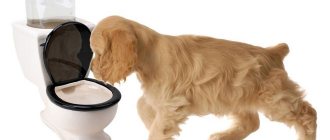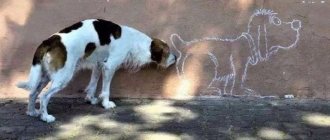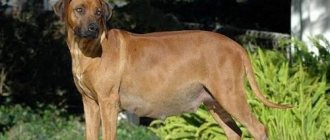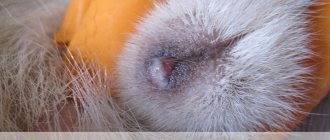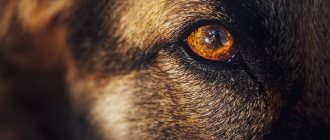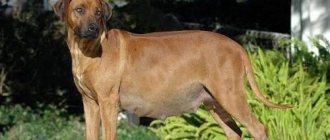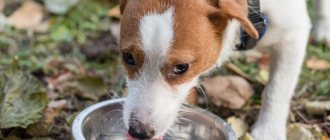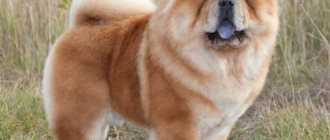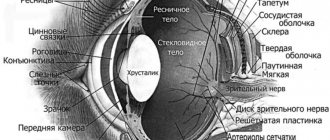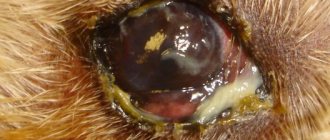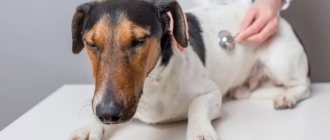The mucous membrane of the large intestine of animals and humans constantly produces a certain amount of mucus - a viscous fluid produced by epithelial goblet cells. Its main functions are softening, lubricating, moisturizing, and protective.
If a dog has mucus in his stool, this may be a consequence of intestinal motility, but it may also indicate a pathology of the digestive system.
Causes
Under normal conditions, some amount of intestinal mucus is always excreted in the stool. This oily, jelly-like substance is produced by the glands of the intestines. The body needs it to neutralize the effect of pathogenic microflora, protect the intestines from the destructive effects of toxic components of feces, and prevent mechanical damage to its walls from undigested food fibers.
The mucus of the large intestine also serves as a kind of lubricant, which ensures the rapid movement of feces to the anus. Its absence could cause constant constipation.
In what case is the release of intestinal mucus during bowel movements a physiological reaction, and when is it a symptom of a particular disease?
If the dog remains active (eats well, loves to play), then most likely the release of mucus during bowel movements is normal . If any painful symptoms are present (severe diarrhea, vomiting, pain), then the dog apparently has a health problem .
Physiological reaction of the body
The appearance of mucus in the stool may be a consequence of a violation of the diet and an unbalanced diet, namely:
- Mixed feeding . A sudden transition from dry food to natural food and back is harmful to the digestive system and can cause unwanted reactions.
- Poor quality feed. Cheap foods often contain preservatives and dyes that have an aggressive effect on the mucous membrane of the stomach and intestines.
- Regular overfeeding. (see how many times a day to feed a dog) A large amount of fatty foods and a lack of fiber have a particularly negative effect on the animal’s condition.
Other reasons include drinking poor quality water, hypothermia, and stressful situations.
Pathology
Pathological lesions of the intestine cause irritation of its walls. As a result, a protective reaction of the body occurs in the form of increased secretion of mucous secretion.
Its color may vary depending on the nature of the disease.
The yellow color of the mucus indicates drug damage to the intestines or polyps; the appearance of green discharge is provoked by pathogenic microflora; a pink tint to the secretion indicates purulent inflammation of the mucous membrane. Clear discharge usually appears when the distal (distant) parts of the intestine are affected.
Mucus in a dog’s stool can be a symptom of the following pathologies:
- food allergies;
- pathologies of the rectum (anal fissures, neoplasms);
- colitis (infectious inflammation of the walls of the large intestine);
- dysbacteriosis;
- helminthiases;
- gastroenteritis.
Pay attention to the article: The dog has green feces.
Liver diseases
With liver disease, stool becomes not mucous, but “greasy.” Moreover, in the literal sense of the word. Since the liver either stops producing bile, or its entry into the intestinal lumen is for some reason difficult, the breakdown and absorption of lipids stops. This causes the feces to become slimy and very sticky. If your dog is a “pocket” breed, this is very easy to notice when you wash his litter box every day.
Contrary to popular belief, with “liver” pathologies, yellow stool does not happen!
Diagnosis and treatment
Mucus in the stool can indicate the presence of a number of diseases. Therefore, a dog with this disorder requires comprehensive diagnosis and treatment.
Progress of diagnostic measures
It is mandatory to conduct an external examination of the dog and interview the owner about the conditions of feeding and care.
A stool analysis provides a lot of information. With its help, the presence or absence of helminths in the intestines, the content of latent blood in the stool is revealed, and the inflammatory process is diagnosed. If colon tumors are suspected, a colonoscopy or MRI using a contrast agent is performed.
Before making a diagnosis, the doctor analyzes the clinical picture. In this case, the entire complex of symptoms is considered. Their combination, the predominance of some over others, and the brightness of their manifestation are taken into account:
- Inflammatory bowel diseases are characterized by an acute course, watery stools, and rapid onset of general symptoms.
- Anal fissures are always accompanied by severe pain. Defecation occurs with the release of a small amount of scarlet blood.
- Colitis of autoimmune etiology is usually characterized by strong urge in the absence of stool. During the urge, mucus of a characteristic greenish hue is released.
- In cases of pathology of the body's enzymatic system, feces usually contain remnants of undigested food.
- Helminth infections are characterized by severe itching of the anus, pain in the abdominal area, nausea, and abdominal enlargement.
Treatment
Treatment tactics differ in each case. The veterinarian-gastroenterologist, based on the results of the diagnostics, selects a regimen. Then the doctor makes appointments, monitors the treatment process, and, if necessary, makes adjustments.
- Food allergies are treated by strict adherence to a diet and the use of antihistamines. The allergen, the food or product that caused the allergic reaction, is excluded from the diet. Read more about dog food allergies.
- In case of dysbacteriosis, treatment should be comprehensive. To remove toxins and pathogenic microflora, sorbents are prescribed and infusion therapy is carried out. Then probiotics and prebiotics are prescribed to populate the intestines with beneficial microflora. Immunomodulator drugs are prescribed to maintain the body's defenses.
- For colitis, therapeutic fasting is recommended. Upon completion (after 2 days), improvement occurs (normal stool is restored). Then a therapeutic diet is developed for the dog. Fatty and carbohydrate foods are excluded. Medicines prescribed include drugs that eliminate diarrhea (Loperamide) and antimicrobial agents (Metronidazole). To restore water and electrolyte balance, droppers with potassium chloride are prescribed.
- Helminthiasis is treated by prescribing anthelmintic drugs. The dog is given special medications in a dosage appropriate to its age and size. After deworming, it is necessary to remove dead helminths from the body as soon as possible to eliminate the possibility of poisoning. To do this, it is recommended to give the dog a laxative or give an enema.
- When selecting a treatment regimen for gastroenteritis, attention is paid to its nature. Viral intestinal infections are treated with antiviral drugs. If the cause of the disease is poisoning of the body, then gastric lavage is done and antidotes are used. If gastroenteritis is a reaction to the use of potent drugs, then they are discontinued. If it is impossible to do this, reduce the dosage and prescribe gastroprotectors.
To stop severe diarrhea with blood and mucus, strengthening drugs are prescribed and the body is dehydrated.
Colitis
Colitis is an inflammation of the large intestine . There can be many reasons for this phenomenon, from infectious diseases to all kinds of poisoning. But there is only one outcome - the colon mucosa becomes inflamed, most often of the catarrhal type, when a large volume of mucus is released.
How can you understand that your pet has colitis and not something else? It is quite difficult to do this without the appropriate education and skills, but there are still specific signs:
- The pet constantly asks to go for a walk in order to go “big”, but he is not doing well with the act of defecation. No matter how much the dog strains, feces are not released, or it comes out, but in portions and with a lot of mucus.
- The process of defecation is accompanied by a pronounced pain reaction. The dog howls and wheezes, trying to squeeze something out of himself.
- The animal begins to vomit . Very strong and “explosive”, vomit literally flows out of pets like a fountain. This is due to the fact that compressed feces in the inflamed intestines are a real toxic “bomb”. Simply put, a powerful source of toxins appears in the dog’s body.
Unfortunately, owners of sick dogs do not always take their pets to the veterinarian. Moreover, they try to cure them of “constipation” on their own by giving them oils and other “potions.” It’s not difficult to guess what all this leads to - the disease “ripens” to an extremely advanced stage; during defecation, not just mucus flies out of the animal, but a mixture of blood and exfoliated areas of the epithelium. If you don’t help the dog in time, it will die (and no one can guarantee successful treatment in such situations).
When to see a veterinarian
Active production of mucous secretion by the intestinal glands does not always indicate pathology. Sometimes the reason for bowel dysfunction is very simple. If it is associated with errors in nutrition or improper care of the animal, then you do not need to consult a doctor. The stool will recover on its own as soon as the correct feeding and care regimen is introduced.
Sometimes, observing the dog’s behavior helps to understand how serious the cause of feces with mucus is. If the animal feels well, is active and cheerful, then there is no reason to worry.
And if episodes of mucous diarrhea are repeated frequently, the pet is lethargic, does not eat anything, and refuses to walk, then this should alert you.
In this case, you cannot hesitate, since severe diarrhea quickly causes dehydration, and then death. The risk of such complications is especially high in puppies and older dogs.
Poor quality food
Much more often, the cause of mucous diarrhea is simply poor quality, spoiled food . And it goes to dogs really often.
Firstly, these animals have an unpleasant habit of digging in any available garbage heap, where there may well be remnants of spoiled and discarded food.
Secondly, many inexperienced and overly “frugal” breeders feed expired food to their pets (which is strongly not recommended).
Interesting! There is an opinion that the digestive system of dogs is very “strong”, but this is not entirely true. They can indeed eat “tasty” meat without any consequences, but this does not apply to rotten food.
If you regularly feed your dog the stale contents of your refrigerator, do not be surprised that your pet will regularly smear mucous masses. What’s even worse is that the kidneys and liver suffer greatly from such “delicacies.” But there are more dangerous causes of diarrhea with mucous inclusions.
Prevention
Stool with mucus in dogs may indicate the onset of a serious disease of the digestive system. To reduce the risk of intestinal pathologies, carry out constant prevention.
The main rule is careful control of the dog’s diet.
Food must be of high quality and fresh. It is advisable to choose premium food with a minimum content of artificial additives. If the feeding is natural, then the diet must be carefully balanced.
In addition, it is useful to strengthen the animal’s body. Walking in the fresh air and outdoor games will help. It is important to do regular deworming. It is recommended to bring your dog to the clinic for preventive examinations twice a year. When the first painful symptoms appear, do not hesitate. Early contact with a veterinarian, thorough diagnosis and timely treatment are the key to stopping the disease at an early stage and allowing your four-legged friend to be active and cheerful again.
Dysbacteriosis
It should be noted that today the existence of this diagnosis is questioned by many experts, but in the case of dogs, pathology certainly exists. It's all about the structural features and physiology of the intestines in canines. Evolutionarily, it turned out that the total length of their gastrointestinal tract is quite small.
In combination with other factors, this leads to the fact that most of the beneficial microflora from the dog’s intestines is simply “washed out” with each act of defecation. It is for this reason that dogs on walks look for and eat other people’s feces... This is a kind of “health coprophagia”.
For dogs, long-term and uncontrolled use of antibiotics and other antibacterial drugs is much more dangerous than if you compare them with other animals. The microflora in their intestines is hardly killed instantly, but its restoration occurs very, very “slowly.”
If there are no beneficial bacteria, pathogenic and conditionally pathogenic microbes multiply in the intestines, which leads to inflammation and diarrhea with mucus and blood. To prevent this from happening, dogs must (!) be given probiotics after a course of any antimicrobial drug . “Human” Linex has proven itself quite well.
But if there is such an opportunity, it is much better to buy drugs in the form of a liquid fraction. There are much more living microorganisms there, and therefore their effect is much higher.
What to do if there is blood in your dog's stool?
First and most importantly, do not self-medicate. A variety of reasons can cause bleeding, so it is impossible to identify them at home. Not only will you not help your pet, but you will also aggravate an already difficult situation.
Therefore, if you find blood in your stool, seek professional help immediately. Before coming to the veterinarian, prepare answers to several questions:
- What did you feed your dog for the last 2-3 days?
- Could your pet pick up an inedible object on the street or at home?
- Have similar situations happened before?
- Do you give your pet any medications?
If possible, take a photo of bloody stool. Do not throw away the stool; prepare it for laboratory testing. This will significantly save your time and allow the veterinarian to take all necessary measures in a timely manner.
If contacting a specialist is delayed for certain reasons, exclude dry food and solid food from the dog’s diet. This way you will be sure that it does not injure the mucous membranes of the gastrointestinal tract.
Under no circumstances should you apply cold/heat to your dog’s belly. Do not prescribe medications yourself. And most importantly, don’t panic. Drops of blood in the stool can be disposable and self-limiting, but, of course, this does not exclude the need for a full and professional examination.
Diarrhea in a puppy: the main thing
- Diarrhea in puppies is quite common and often goes away on its own without treatment.
- Prolonged diarrhea or complicated by vomiting, refusal to eat, lethargy, or bleeding is extremely dangerous for small puppies.
- Treatment will depend on the cause of the diarrhea.
- Timely treatments, vaccination and proper feeding are the best ways to prevent diarrhea.
Therapy for piroplasmosis
This disease develops in a dog as a result of a bite from an infected tick. The animal experiences shortness of breath and apathy, and the mucous membranes become yellow. In addition, there is a sharp increase in body temperature, frequent vomiting occurs, and diarrhea begins, in which blood and mucus appear.
If a dog has piroplasmosis, the veterinarian will prescribe the use of Ketazol and Dexamethasone. They are injected under the animal's skin. You should also strictly follow the dosage indicated in the instructions. Taking too much of the drug can lead to even greater problems than before.
